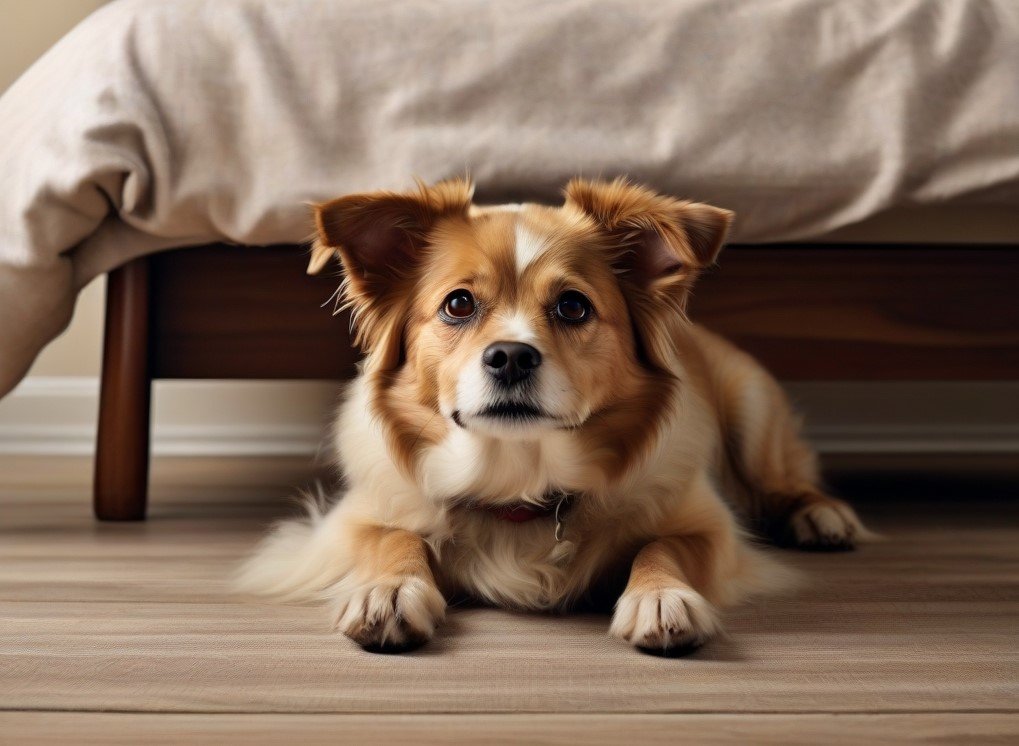Dogs can sometimes behave in puzzling ways, and hiding under the bed is one of them. You might wonder why your furry friend chooses this spot instead of staying close to you. There are several reasons why dogs hide under the bed, including fear, anxiety, or even just a desire for a quiet, safe space.
If your dog is feeling scared due to loud noises, unfamiliar people, or other stressors, they may seek comfort in the darkness beneath the bed. It’s important to pay attention to their behaviour, as this can also indicate they are feeling unwell or overwhelmed. You can help your dog feel more secure by creating a cosy area just for them, making it clear that they have a safe place to retreat when they need to.
Understanding these actions can strengthen the bond between you and your pet. By learning more about their behaviour, you can provide the support they need and ensure they feel safe and happy in your home.
Understanding Canine Behaviour
Dogs often display unique behaviours, and hiding under the bed can be one of them. It’s important to recognise the signs of stress in your dog and identify common reasons for their anxiety.
Canine Stress Signals
When your dog is stressed, they may display specific behaviours. Look out for:
- Panting: Excessive panting can indicate nervousness.
- Pacing: If your dog walks in circles or seems restless, they might be anxious.
- Barking: Increased barking can be a response to stress or fear.
- Shaking: Trembling can signal that your dog is frightened or uncomfortable.
These signals are their way of communicating. If you notice such behaviours frequently, it might be time to investigate the underlying causes of their stress.
Common Causes of Anxiety in Dogs
Several factors can lead to anxiety in dogs. Some of the most common include:
- Loud noises: Thunder, fireworks, or vacuum cleaners can trigger fear.
- Separation anxiety: If your dog becomes anxious when you’re away, it may seek comfort by hiding.
- Changes in environment: Moving homes or introducing new pets can upset them.
- Unfamiliar situations: New people or changes in routine can make your dog uneasy.
Understanding these triggers will help you create a more supportive environment for your furry friend. Addressing their needs can reduce their urge to hide.
Reasons Dogs Hide Under the Bed
Sometimes, your dog may feel the need to retreat under the bed. This behaviour can be linked to several key factors, including their instinct for safety, potential health issues, and reactions to frightening noises or sights. Here’s a closer look at these reasons.
Seeking Safety and Comfort
Dogs instinctively look for safe spaces when they feel threatened. Hiding under the bed provides them with a sense of security, as it is a confined area away from potential dangers.
If your dog is feeling anxious, they may seek comfort in small, enclosed spaces. This behaviour is often more pronounced in dogs that have experienced a traumatic event. You might notice them retreating during stressful situations, such as visits from unfamiliar people or loud gatherings.
Providing your dog with a designated safe space or crate can help them feel more secure. Encourage them by placing their favourite toys and blankets in that area. This can create a refuge they can choose when feeling uneasy.
Illness or Injury
Sometimes, dogs hide because they are not feeling well. If your dog seems lethargic or is hiding for an extended period, it might be a sign that they are unwell or in pain.
Look for other symptoms, such as changes in appetite, unusual behaviour, or signs of discomfort. If you suspect an illness or injury, it is essential to consult with your vet. Early detection can lead to better treatment outcomes.
Ensure you keep an eye on your dog’s habits. If hiding becomes more frequent or is accompanied by worrying symptoms, investigating further is crucial.
Fear Responses to External Stimuli
Loud noises, like thunderstorms or fireworks, can cause significant fear in dogs. These sounds may trigger a flight response, leading them to seek refuge in a place they believe is safe.
Your dog might also hide in reaction to new experiences, such as moving to a new home or being around unfamiliar animals. They may not yet feel secure in their environment.
If your dog’s fear is intense, consider using calming techniques. Some dogs benefit from positive reinforcement training. This can help them feel more secure around loud noises or sudden changes in their surroundings.
Understanding these reasons can help you address your dog’s needs better.
Environmental and Social Factors
Your dog’s behaviour can be influenced by various environmental and social factors. Understanding these aspects can help you see why your pet seeks refuge under the bed.
Interactions With Other Pets
If you have multiple pets, your dog may feel stressed due to their interactions. A new pet can change the dynamics in your home, making your dog feel insecure.
Signs of stress can include:
- Hiding under furniture
- Avoiding other pets
- Aggressive behaviour towards them
Pay attention to how your dog interacts with others. If they seem anxious, consider creating separate spaces for your pets. This can provide a sense of security. Setting up areas where they can retreat will help your dog feel more at ease.
Changes in the Household
Changes in your household can greatly affect your dog’s behaviour. This could include moving to a new home, getting a new family member, or even changes in your routine.
Common indicators of stress include:
- Increased hiding behaviour
- Changes in appetite
- Withdrawal from family members
If your dog is feeling unsettled, they might seek safety under the bed. Providing a stable environment is crucial. Keep routines consistent when possible. This helps your dog adjust to changes and feel safe in their home.
Approaching a Hiding Dog
When you notice your dog hiding under the bed, it’s essential to approach them carefully. Your actions can significantly impact how they feel and respond to you. Focus on safety and trust to create a positive experience for both of you.
Safety Considerations
Before approaching, make sure you’re calm and quiet. Sudden movements or loud noises can startle your dog further. Speak softly and gently to show you mean no harm.
Key tips:
- Get Low: Bend down to your dog’s level. This makes you seem less threatening.
- Avoid Sudden Movements: Move slowly to give your dog time to adjust.
- Give Space: Allow your dog to come to you when they are ready. Forcing them out may increase their fear.
By ensuring a safe environment, you help your dog feel more secure and less anxious.
Building Trust
Establishing trust is vital for helping your dog feel safe. You can use treats or toys to create positive associations with you.
Ways to build trust:
- Use Treats: Offer a favourite treat from a distance. This encourages your dog to come closer.
- Meet Their Needs: Pay attention to their signs of fear. You might need to turn off loud music or create a cosy spot nearby.
- Be Patient: Allow your dog time to adjust. Forcing interactions can lead to more hiding.
Building trust takes time, but your patience and understanding will help your dog feel safe and loved.
Improving Your Dog’s Environment
Creating a comfortable environment is key for your dog. By offering safe spaces and establishing a routine, you can reduce their anxiety. Here’s how to enhance your dog’s living space.
Creating Safe Spaces
Designate a quiet area in your home where your dog can retreat. This could be a specific room or a corner with a comfortable bed or blanket. Adding familiar toys can help your dog feel more secure.
Consider using a crate if your dog is crate-trained. Make it a positive space with treats and toys. You might also use a puppy gate to limit access to certain areas.
Observe where your dog likes to hide. If they prefer under the bed, ensure it’s clean and free from clutter. Create boundaries that help them feel safe and protected from loud noises or other stressors.
Routine and Training
Establishing a consistent daily routine can help your dog feel more secure. Feed them at the same times each day and ensure regular potty breaks. Regular walks are also crucial; they offer mental and physical stimulation.
Training sessions are equally important. Use positive reinforcement to teach commands and social behaviour. This not only helps with behaviour but strengthens your bond.
Keep training sessions short and engaging. Aim for 5 to 10 minutes each, focusing on fun games involving treats. A structured yet playful approach can make a big difference in their comfort levels.
When to Seek Professional Help
It’s important to recognise when your dog’s behaviour signals a need for professional guidance. Prompt action can lead to better outcomes for both you and your furry friend. Keep an eye out for key behavioural changes and know when to consult a veterinarian.
Behavioural Changes to Monitor
Watch for signs that your dog is experiencing more than just occasional fear or anxiety. If your dog hides frequently or shows signs of distress, it may be time to seek help.
Key behaviours to note include:
- Increased hiding: If hiding under the bed becomes a regular occurrence.
- Excessive barking: Sudden and frequent barking, especially when alone.
- Changes in appetite: Eating less or refusing food altogether.
- Aggression or fearfulness: Reacting negatively to usual situations or people.
These behaviours can indicate a deeper issue. Keeping a record can help when discussing your dog’s behaviour with a professional.
Consulting a Veterinarian
If your dog’s anxiety or fearfulness doesn’t improve, consider visiting a veterinarian. They can help rule out medical conditions that may cause behavioural changes.
A vet will assess your dog’s health and behaviour. They might recommend:
- Behavioural therapy: Working with a professional dog trainer.
- Medication: For severe anxiety or fear issues.
Early intervention is key. By addressing problems sooner rather than later, you can help your dog feel more relaxed and secure in their environment.

